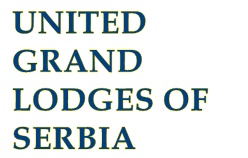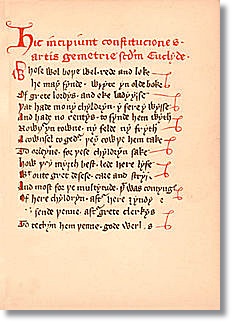
Halliwell Manuscript, also known as Regius Poem
(1425 -50AD)
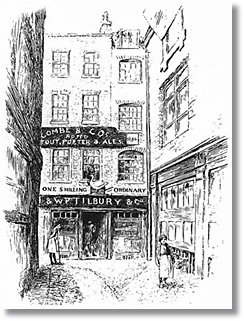
On 24 June 1717, four London lodges met for a joint
dinner at Goose and Gridiron where the Grand Lodge
of England was founded.
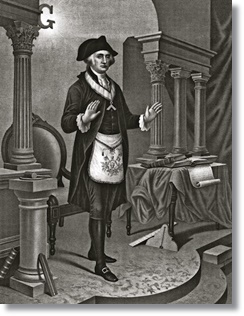
George Washington was the first President
of the United States and a Freemason
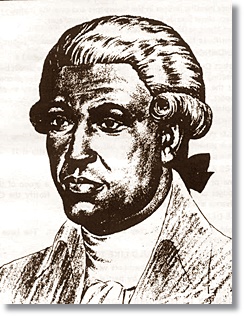
Prince Hall
was initiated into a British military lodge
with a warrant from the Grand Lodge of Ireland in 1775.
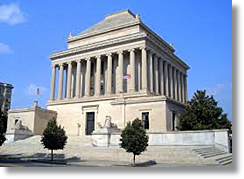
House of Temple, Washington DC
The Seat of the AASR for Southern Jurisdiction USA

Grand Lodge of New York Building
at 75 W 23rd Str. in New York
|
|
HISTORY OF FREEMASONRY
Early Beginnings – England, Scotland, and Ireland
Many Masonic historians relate the origins of Freemasonry with a series of documents known as the Old Charges, dating from the Regius Poem in about 1425 to the beginning of the 18th century. Alluding to the membership of a lodge of operative masons, they present a legendary history of the craft, the duties of its grades, and the manner in which oaths of fidelity are to be taken on joining. The fifteenth century also brings us the first evidence of ceremonial regalia.
It is not completely clear how these local trade organizations became today's Masonic lodges, but the earliest rituals and passwords known, from operative lodges around the turn of the 17th-18th centuries, show continuity with the rituals developed in the later 18th century by accepted or speculative Masons, as those members who did not practice the physical craft came to be known. The minutes of the Lodge of Edinburgh (Mary's Chapel) No.1 in Scotland show a continuity from an operative lodge in 1598 to a modern speculative lodge. It is reputed to be the oldest Masonic lodge in the world.
The first Grand Lodge, the Grand Lodge of London and Westminster (later called the Grand Lodge of England (GLE), was founded on 24 June 1717, when four London lodges met for a joint dinner at thew Goose and Gridiron Ale House. Many English Lodges joined the new body, which itself entered a period of self-publicity and expansion. However, many lodges could not endorse changes which some lodges of the GLE made to the ritual (they came to be known as the Moderns), and a few of these formed a rival Grand Lodge on 17 July 1751, which is now known as the "Antient Grand Lodge of England." These two Grand Lodges vied for supremacy until the Moderns promised to return to the ancient ritual. They united on 25 November 1813 to form the United Grand Lodge of England (UGLE).
The Grand Lodge of Ireland and the Grand Lodge of Scotland were formed in 1725 and 1736 respectively, although neither persuaded all of the existing lodges in their countries to join for many years.
North America
The earliest known American lodges appeared in Pennsylvania. The Collector for the port of Pennsylvania, John Moore, wrote of attending lodges there in 1715, two years before the formation of the first Grand Lodge in London. The Premier Grand Lodge of England appointed a Provincial Grand Master for North America in 1731, based in Pennsylvania. Other lodges in the colony obtained authorizations from the later Antient Grand Lodge of England, the Grand Lodge of Scotland, and the Grand Lodge of Ireland, which was particularly well represented in the travelling lodges of the British Army. Many lodges came into existence with no warrant from any Grand Lodge, applying and paying for their authorization only after they were confident of their own survival.
After the American Revolution, independent U.S. Grand Lodges formed themselves within each state. Some thought was briefly given to organizing an overarching "Grand Lodge of the United States," with George Washington (who was a member of a Virginian lodge) as the first Grand Master, but the idea was short-lived. The various state Grand Lodges did not wish to diminish their own authority by agreeing to such a body.
Prince Hall Freemasonry
Prince Hall Freemasonry came into existance because of the refusal of early American lodges to admit African-Americans. In 1775, an African-American named Prince Hall, along with fourteen other African-Americans, was initiated into a British military lodge with a warrant from the Grand Lodge of Ireland, having failed to obtain admission from the other lodges in Boston. When the military Lodge left North America, those fifteen men were given the authority to meet as a Lodge, but not to initiate Masons. In 1784, these individuals obtained a Warrant from the Premier Grand Lodge of England (GLE) and formed African Lodge, Number 459. When the UGLE was formed in 1813, all U.S.-based Lodges were stricken from their rolls – due largely to the War of 1812. Thus, separated from both UGLE and any concordantly recognized U.S. Grand Lodge, African Lodge re-titled itself as the African Lodge, Number 1 – and became a de facto "Grand Lodge" (this Lodge is not to be confused with the various Grand Lodges on the Continent of Africa). As with the rest of U.S. Freemasonry, Prince Hall Freemasonry soon grew and organized on a Grand Lodge system for each state.
Widespread segregation in 19th- and early 20th-century North America made it difficult for African-Americans to join Lodges outside of Prince Hall jurisdictions – and impossible for inter-jurisdiction recognition between the parallel U.S. Masonic authorities. By the 1980s such discrimination was a thing of the past, and today most U.S. Grand Lodges recognize their Prince Hall counterparts, and the authorities of both traditions are working towards full recognition. The United Grand Lodge of England has no problem with recognizing Prince Hall Grand Lodges. While celebrating their heritage as lodges of black Americans, Prince Hall is open to all men regardless of race or religion.
Freemasonry in the continental Europe
English Freemasonry spread to France in the 1720s, first as lodges of expatriates and exiled Jacobites, and then as distinctively French lodges which still follow the ritual of the Moderns. From France, Ireland, Scotland, and England, Freemasonry spread to most of Continental Europe, and to the colonies in Australia, New Zeeland, Asia, and Africa during the course of the 18th and 19th century.
It was growing continuously in most of the European countries throughout next two cewnturies, all until the appearance of fascism in Italy, Nazism in Germany and dictatorships in Hungary, Spain and Portugal, where Freemasonry was outlawed. Freemasonry continued to be forbidden in the Eastern European countries during the Cold War, but with the fall of communist systems in Eastern Europe by the 1990 it was renewed in most of the former communist countries.
Today, there are over five million Freemasons in over five hundred Grand Lodges and Grand Orients throughout the world. The fraternity is administratively organized into independent Grand Lodges (or sometimes Grand Orients), each of which governs its own Masonic jurisdiction, which consists of subordinate (or constituent) Lodges. The largest single jurisdiction, in terms of membership, is the United Grand Lodge of England (with a membership estimated at around a quarter million). The Grand Lodge of Scotland and Grand Lodge of Ireland (taken together) have approximately 150,000 members. In the United States total membership is just under two million. There is no single overarching governing body that presides over worldwide Freemasonry; connections between different jurisdictions depend solely on mutual recognition.
|
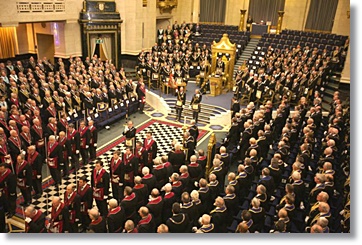
United Grand Lodge of England at its Session
|
Chronology Of Freemasonry
|
RECOGNITION, AMITY
AND REGULARITY
Relations between Grand Lodges are determined by the concept of Recognition. Each Grand Lodge maintains a list of other Grand Lodges which it recognizes. When two Grand Lodges recognize and are in Masonic communication with each other, they are said to be in amity, and the brethren of each may visit each other's lodges and interact Masonically. When two Grand Lodges are not in amity, inter-visitation is not allowed. There are many reasons why one Grand Lodge will withhold or withdraw recognition from another, but the two most common are Exclusive Jurisdiction and Regularity.
Exclusive Jurisdiction is a concept whereby only one Grand Lodge will be recognized in any geographical area. If two Grand Lodges claim jurisdiction over the same area, the other Grand Lodges will have to choose between them, and they may not all decide to recognize the same one. Exclusive Jurisdiction can be waived when the two overlapping Grand Lodges are themselves in Amity and agree to share jurisdiction (for example, since the Grand Lodge of Connecticut is in Amity with the Prince Hall Grand Lodge of Connecticut, the principle of Exclusive Jurisdiction does not apply, and other Grand Lodges may recognize both).
Regularity is a concept based on adherence to Masonic Landmarks, the basic membership requirements, tenets and rituals of the craft. Each Grand Lodge sets its own definition of what these landmarks are, and thus what is Regular and what is Irregular (and the definitions do not necessarily agree between Grand Lodges). Essentially, every Grand Lodge will hold that its landmarks (its requirements, tenets and rituals) are Regular, and judge other Grand Lodges based on those. If the differences are significant, one Grand Lodge may declare the other "Irregular" and withdraw or withhold recognition.
The most commonly shared rules for Recognition (based on Regularity) are those given by the United Grand Lodge of England in 1929:
-The Grand Lodge should be established by an existing regular Grand Lodge, or by at least three regular lodges.
-A belief in a Supreme Being and scripture is a condition of membership.
-
Initiates should take their vows on that scripture.
-Only men can be admitted, and no relationship exists with mixed lodges.
-The Grand Lodge has complete control over the first three degrees, and is not subject to another body.
-All lodges shall display a volume of scripture with the square and compasses while in session.
-There is no discussion of politics or religion. |
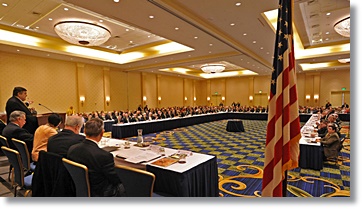
Conference of Grand Masters of North America

World Conference of Grand lodges
|

